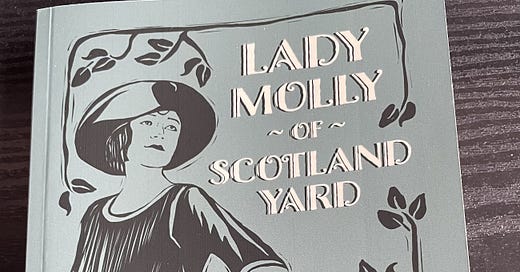Lady Molly of Scotland Yard by Baroness Orczy
An Edwardian female detective from the author of the Scarlet Pimpernel
Having enjoyed all the Scarlet Pimpernel novels I read in my late teens and early twenties, I pounced on this short story collection by the same author the moment I spotted it in a charity shop. A lady detective in Edwardian London, you say? Don’t mind if I do.
Lady Molly is a mysterious young woman attached to Scotland Yard, and she is greatly respected by the chaps in charge. Her true identity is concealed for much of the book — as with Margery Allingham’s Albert Campion twenty years later, there is a hint she’s an aristocrat of some sort but it is left deliberately mysterious. She is usually called in when ‘female intuition’ is called for, in a case that is leaving the over-logical men of Scotland Yard stumped, and she is assisted by Mary Granard.
Mary is her Dr Watson, tagging along and exclaiming with admiration, then writing Lady Molly’s escapades up later for a wider audience. Mary is a little bit in love with her colleague, repeatedly referring to her as ‘the woman I love best in all the world’, but as with Holmes and poor old Watson it does sometimes seem that Molly forgets she exists. Like Holmes too, Molly is ever eager to don disguises and visit unexpected places.
The twelve stories in this collection were first published in 1910 and are very much of their time. I have the Renard Press edition from 2023 which says some of the language has been updated to make it easier for a modern audience (a shame, in my view) but of course still present are the casual antisemitism, the sexism, the underlying assumption that the old hierarchical society is both right and proper, and eternal. The words slattern and slatternly are often used of the lower orders and their dwellings. Having said that, just because the existing hierarchy is reinforced doesn’t mean the aristocracy and gentry within these pages aren’t guilty of fraud and murder.
The first ten stories appear to be entirely separate cases and could probably be read in any order. However, the final pair seem more like one story chopped into two parts and they spoil the book, in my view. They have a slightly different, more sentimental, character to the others and reveal Lady Molly’s surname, parentage and dramatic backstory, throwing a different light on the cases that came before. Added to that, the plot of part two revolves around someone being courted by a man who has been explained to be her half-brother in part one. I’m not sure whether they were originally written for magazines, Orczy did write some magazine stories — if so, it’s possible she’d forgotten the half-sibling detail by the time the second part was written.
However, these are some of the first stories featuring a female detective, and by one of the members of the Detection Club in the 1930s alongside the likes of Agatha Christie and Dorothy L Sayers. If you like Campion and Sherlock Holmes you’ll probably enjoy the first ten stories in the collection, at any rate. It is newly available this year at Project Gutenberg as well, if you’re curious.





Oh, fun, thank you! Loved The Scarlet Pimpernal as a kid snd had never heard of these!
Interesting. I enjoyed the Scarlet Pimpernel books as a kid, but never knew about these.